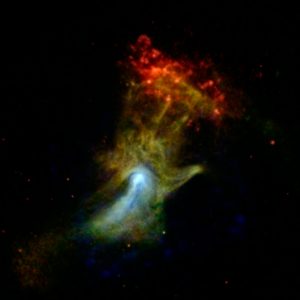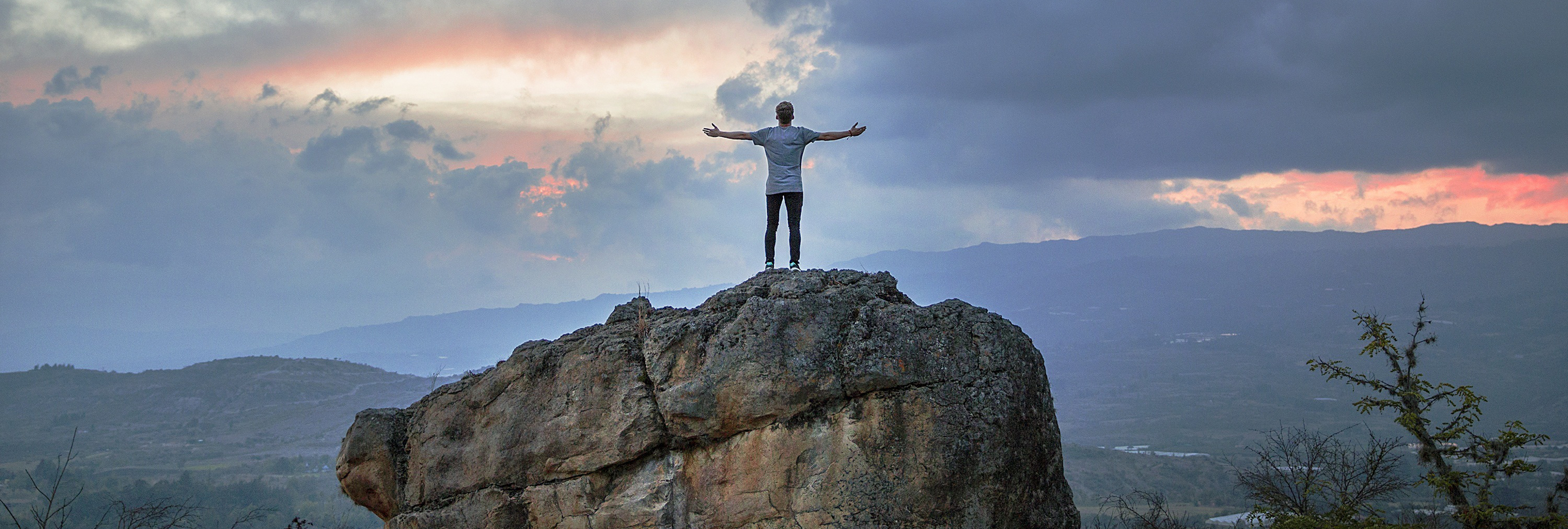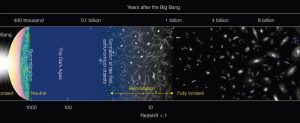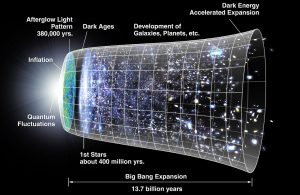In The Beginning
There has to be a beginning, a catalyst that will enlighten us about our universe.
Was it God? Was it just the random fusion of gaseous matter! Or both.
Maybe we have reality wrong and we are just a reflection of a higher existence. Could an entity from another dimension of existence create or manifest stars and planets at will and place them wherever it desired in a lower dimension.
Unfortunately inter-dimensional interaction is beyond our understanding at this point in time. All we have available to us today, whether right or wrong, is the thoughts and conjecture of man. One can only work with the information and data at hand.
Well! Let there be light. The first stars were thought to be the Population III stars, followed by the Population II stars. Maybe the existing dust and gases of the early universe triggered by gravitational forces and the supernovas of the Population stars formed into Nebula. Did this Nebula in turn help create the stars of our now known universe? You be the judge…
Population III Stars – are a hypothetical population of extremely massive and hot stars with virtually no metals, except possibly for intermixing ejecta from other nearby Population III supernovas. It is thought that they were composed entirely of the primordial gas such as hydrogen, helium and very small amounts of lithium and beryllium. They think that they are observable in the quasar emission spectra and are also thought to be components of faint blue galaxies. But their existence is inferred from physical cosmology, they have not yet been observed directly.
Population II Stars – were presumably created from interstellar gas clouds that emerged shortly after the big bang. They would be relatively rich in hydrogen and helium but poor in elements heavier than helium, containing 10 to 100 times less of these elements than Population I stars. Population II stars are apparently found in globular clusters and in the halo of both spiral and elliptical galaxies. Some are found in the bulge of galaxies. Those found in the galactic halo would be older and thus more metal poor.
Nebula
A nebula is a giant cloud of dust and gas in space. Some nebulae, (more than one nebula), come from the gas and dust thrown out by the explosion of a dying star, such as a supernova. Other nebulae are regions where new stars are beginning to form. For this reason, some nebulae are called “star nurseries.”
Nebulae gases consist of mostly hydrogen and helium. The dust and gases in a nebula are very spread out, but it is thought that gravity can slowly begin to pull together these clumps of dust and gas. As these clumps get bigger and bigger, their gravity gets stronger and stronger! Eventually, the clump of dust and gas gets so big that it collapses from its own gravity. The collapse causes the material at the centre of the cloud to heat up. This hot core can be the beginning of a star.
The nebulae that exist in the space between the stars, is also known as interstellar space. The closest known nebula to Earth is called the Helix Nebula and is approximately 700 light-years away. It is the remnant of a dying star, possibly one like the Sun.
Dark nebula, (absorption nebula), is a type of interstellar cloud that is so dense that it obscures the light from objects behind it, such as background stars and emission or reflection nebulae. The extinction of the light is caused by interstellar dust grains located in the coldest, densest parts of larger molecular clouds. Clusters and large complexes of dark nebulae are associated with Giant Molecular Clouds. Isolated small dark nebulae are called Bok globules.
Most nebulae can be described as diffuse nebulae, which means, that they are extended and contain no well-defined boundaries. Diffuse nebulae can be divided into emission nebula (The Omega Nebula), reflection nebula (Herbig–Haro object HH 161 and HH 164) and dark nebula (Horsehead Nebula).
Star Classification
Morgan–Keenan (MK) – is a star classification system that uses the letters O, B, A, F, G, K, and M. The stars are easily classified from the hottest (O) to the coolest, (M). While the simple addition of a number from 0 to 9 is used to further subdivide a star into a spectral class to form a sequence from hot to cool, e.g. A8, A9, F0, F1.
White stars – are not always singular stars. The majority of perceived white stars are actually part of either a binary, triplet or multiple star system. Binary stars are two stars in close proximity, which orbit around their common centre of mass. A star system or stellar system is a small number of stars, (three or more), that orbit each other, bound by gravitational attraction.
A large number of stars bound by gravitation are generally called a star cluster or galaxy. “White Star” is a term given to main-sequence stars that are extremely bright to the eye. They can have masses from 1.4 to 2.1 times the mass of the Sun and surface temperatures between 7,500K and 10,000K. (K = Kelvin).
Examples of apparent White Stars are as follows:
Arcturus – a red giant star in the Northern Hemisphere of Earth’s sky that is the brightest star in the constellation Boötes (the Herdsman). It is the fourth brightest in the night sky and the brightest in the northern celestial hemisphere.
Vega (α Lyrae) – the brightest star in the constellation of Lyra. It is the fifth brightest star in the night sky and the second brightest star in the northern celestial hemisphere after Arcturus. It is relatively close at only 25 light-years from the Sun and together with Arcturus and Sirius is one of the most luminous stars in the Sun’s neighbourhood.
Based on an observed excess emission of infrared radiation, Vega appears to have a circumstellar disc of dust. This dust is likely to be the result of collisions between objects in an orbiting debris disk, which is analogous to the Kuiper belt in the Solar System. Stars that display infrared excess due to dust emission are termed Vega-like stars.
Procyon – a binary star system in Canis Minor (the lesser dog), which is a constellation in the Northern Hemisphere. It is among the 10 brightest stars from Earth’s sky. The system is made up of Procyon A, (a main sequence star), and Procyon B, (a much smaller white dwarf).
Canis Major (Greater Dog) – is a constellation. This binary system consists of a main-sequence star of spectral type A0 or A1, termed Sirius A, (Dog Star), and a faint white dwarf companion of spectral type DA2, designated Sirius B. The distance between the two varies between 8.2 and 31.5 astronomical units as they orbit every 50 years.
Alpha Centauri – the closest star system to the Solar System at 4.37 light-years from the Sun. It is a triple star system, consisting of three stars: α Centauri A, α Centauri B, and α Centauri C. Alpha Centauri A and B are Sun-like stars, and together they form the binary star Alpha Centauri AB. Alpha Centauri C (Proxima Centauri) is a small and faint red dwarf, (Class M). Though not visible to the naked eye it is the closest star to our Sun.
Nu Scorpii – a multiple star system in the constellation of Scorpius. It is most likely a septuple star system consisting of two close groups that are separated by 41 arcseconds. Based on parallax measurements, it is approximately 470 light-years from the Sun. The component Nu Scorpii Aa is also named Jabbah.
Cygnus X-1 – a galactic X-ray source in the constellation Cygnus and is widely accepted to be a black hole. It was discovered in 1964 during a rocket flight and is one of the strongest X-ray sources seen from Earth, producing a peak X-ray flux density of 2.3×10−23 Wm−2 Hz−1.
Typical Living Stars
Blue Stars – are of a spectral type O, B and have a typical age of <~40 million years. They are both characterized by the strong, Helium-II, absorption lines in their respective spectra’s. The hydrogen and neutral helium lines in O-type stars are marked weaker than in B-type stars.
Because blue stars are so hot and massive, they have relatively short lives that end in violent supernova events, ultimately resulting in the creation of either black holes or neutron stars. O-type stars have surface temperatures > 30,000 K and B-type stars have surface temperatures of 10,000 – 30,000 K. (K = Kelvin).
Blue stars are commonly found in active star forming regions, particularly in the arms of spiral galaxies, where their light illuminates surrounding dust and gas clouds making these areas typically appear blue.
They are also often found in complex multi-star systems, where their evolution is much more difficult to predict due to the phenomenon of mass transfer between stars, as well as the possibility of different stars in the system ending their lives as supernovas at different times. Examples of blue stars include 10 Lacertae, AE Aurigae, Delta Circini, V560 Carinae, Mu Columbae, Sigma Orionis, Theta1 Orionis C and Zeta Ophiuchi.
Yellow Dwarf Stars – are of a spectral type G and have a typical age of ~4 to ~17 billion years. G-type stars are often mistakenly referred to as yellow dwarf stars. Our Sun is a G-type star, but it is in fact white, since all the colours it emits are blended together. However, the Sun’s visible light is blended to produce white but its visible light emission peaks in the green part of the spectrum. The green component is absorbed and/or scattered by other frequencies both in the Sun itself and in Earth’s atmosphere.
All G-type stars convert hydrogen into helium in their cores, and will evolve into red giants as their supply of hydrogen fuel is depleted. G-type stars have surface temperatures of 5,000 – 6,000 K. Examples of yellow dwarf stars include Alpha Centauri A, Tau Ceti and 51 Pegasi.
Orange Dwarf Stars – are of a spectral type K and have a typical age of ~15 to ~30 billion years. They fall between red M-type and yellow G-type main-sequence stars. K-type stars are of particular interest in the search for extraterrestrial life, since they emit markedly less UV radiation, (that damages or destroys DNA), than G-type stars. K-type stars have surface temperatures of 3,700 – 5,200 K.
They also remain stable on the main sequence for up to about 30 billion years as compared to about 10 billion years for the Sun. K-type stars are also about four times as common as G-type stars, making the search for exoplanets a lot easier. Examples of orange dwarf stars include Alpha Centauri B and Epsilon Indi.
Red Dwarf Stars – are of a spectral type K, M and their typical age is undetermined, but they are expected to burn for several trillion years. They are small and relatively cool stars. However, they are bigger than brown dwarfs but are less than 40 – 50% of the mass of our Sun. They are also much dimmer than our Sun. K-type stars have surface temperatures of 3,700 – 5,200 K and M-type stars have surface temperatures of 2,400 – 3,700 K.
Red dwarfs account for the bulk of the Milky Ways’ stellar population. Typically, red dwarf stars that are more massive than 0.35 solar masses are fully convective, which means that the process of converting hydrogen into helium occurs throughout the star, and not only in the core, as is the case with more massive stars.
Hence, the nuclear fusion process is slowed down and at the same time greatly prolonged, which keeps the star at a constant luminosity and temperature for several trillion years. The process of nuclear synthesis happens so slowly in these stars that the Universe is not old enough for any known red dwarf star to have aged into an advanced state of evolution. Examples of red dwarf stars include Proxima Centauri and TRAPPIST-1.
Stars that are Giants and Supergiants
Supergiants are among the most massive and most luminous stars. Supergiant stars occupy the top region of the Hertzsprung–Russell diagram with absolute visual magnitudes between about −3 and −8. The temperature range of supergiant stars spans from about 3,450 K to over 20,000 K. (K = Kelvin).
Blue Giant Stars – are of a spectral type O, B and occasionally A and have a typical age of ~10 to ~100 million years. They are bright, giant stars that are between 10 and 100 times the size of the Sun and between 10 and 1,000 times its luminosity. O-type stars have surface temperatures >/ 30,000 K and B-type stars have surface temperatures of 10,000 – 30,000 K. A-type stars have surface temperatures of 7,500 – 10,000 K.
The term “blue giant star” has no scientific definition, and is commonly applied to a wide variety of stars that have all evolved off the main sequence. However, for practical reasons, stars with luminosity classifications of III and II, (bright giant and giant) respectively, are referred to as “blue giant stars” purely for convenience, but they have to be above 10,000K. Nonetheless, the term blue giant is often misapplied to some stars simply because they are big and hot.
In practice however, big stars are referred to as “blue giants” when they inhabit a specific region of the H-R diagram, rather than because the star meets a specific set of criteria. Examples of blue giant stars include Iota Orionis, LH54-425, Meissa, Plaskett’s star, Xi Persei and Mintaka.
Blue Supergiant Stars – are of a spectral type OB and have a typical age of ~10 million years. They are scientifically known as OB super giants, and generally have luminosity classifications of I, and spectral classifications of B9 or earlier. A Blue super giant star is typically larger than the Sun, but smaller then a red super giant stars. They fall into a mass range of between 10 and 100 solar masses. O-type stars have surface temperatures >/ 30,000 K and B-type stars have surface temperatures of 10,000 – 30,000 K.
These type-O and early type-B main sequence stars leave the main sequence in only a few million years because they burn through their supply of hydrogen very quickly due to their high masses. These stars start the process of expansion into the blue super giant phase as soon as heavy elements appear on their surfaces, but in some cases, some stars evolve directly into Wolf–Rayet stars, skipping the “normal” blue super giant phase. Because of their mass and hotness, they are relatively short-lived and quickly exhaust their hydrogen fuel, ending as red supergiants or neutron stars.
Examples of blue supergiant stars include UW Canis Majoris (UW CMa), a blue-white (O-type) supergiant; Rigel (ß Orionis), a blue-white (B-type) supergiant; Zeta Puppis (Naos), a blue (O-type) supergiant; 29 Canis Majoris; Alnitak; Alpha Camelopardalis; Cygnus X-1; Tau Canis Majoris and Zeta Puppis.
Wolf–Rayet Stars (WR stars) – are a rare heterogeneous set of stars with unusual spectra showing prominent broad emission lines of highly ionized helium and nitrogen or carbon. The spectra indicate very high surface enhancement of heavy elements, depletion of hydrogen and strong stellar winds.
Red Giant Stars – are of a spectral type M, K and have a typical age of ~0.1 – ~2 billion years. They are of low or intermediate mass, perhaps weighing in at between 0.3 to 10 solar masses. A Red Giant is a main-sequence star that has fused all its hydrogen into helium. K-type stars have surface temperatures of 3,700 – 5,200 K and M-type stars have surface temperatures of 2,400 – 3,700 K.
The Red-Giant branch (RGB) is the most common portion of the giant branch before helium ignition occurs in the course of stellar evolution. It then starts to burn its helium to produce carbon and oxygen, and expands to many times its previous volume to become a red giant.
The Horizontal branch (HB) is a stage of stellar evolution that immediately follows the red giant branch in stars whose masses are similar to the Sun’s. Horizontal-branch stars are powered by helium fusion in the core (via the triple-alpha process) and by hydrogen fusion (via the CNO cycle) in a shell surrounding the core.
The red clump giants are cool horizontal branch stars, (which were originally similar to the Sun), that have undergone a helium flash and are now fusing helium in their cores.
Asymptotic-giant-branch (AGB) is a period of stellar evolution that is undertaken by all low to intermediate mass stars (0.6–10 solar masses) late in their lives. The AGB phase is divided into two parts, the early AGB (E-AGB) and the thermally pulsing AGB (TP-AGB).
During the E-AGB phase, the main source of energy is helium fusion in a shell around a core consisting mostly of carbon and oxygen. During this phase, the star swells up to giant proportions to become a red giant again. After the helium shell runs out of fuel, the TP-AGB starts. Now the star derives its energy from fusion of hydrogen in a thin shell, which restricts the inner helium shell to a very thin layer and prevents it fusing stably.
When a red giant has used up its helium to produce carbon and oxygen and has insufficient mass to generate the core temperatures required to fuse carbon, it sheds its outer layers to form a planetary nebula, and leaves behind an inert mass of carbon and oxygen. After a relatively short time (in the region of two hundred million years), the red giant puffs out its outer layers in a gas cloud called a nebula and collapses in on itself to form a white dwarf. Examples of red giants include Aldebaran, Arcturus and Gacrux
Red Supergiant Stars – are of a spectral type K, M and have a typical age of ~3 million to ~100 million years. They have a supergiant luminosity class of Yerkes I. They are the largest stars in the universe in terms of volume, although they are not the most massive or luminous. K-type stars have surface temperatures of 3,700 – 5,200 K and M-type stars have surface temperatures of 2,400 – 3,700 K.
Red supergiants have exhausted their supply of hydrogen at their cores and as a result, their outer layers expand hugely as they evolve off the main sequence. In rare cases, red supergiant stars are massive enough to fuse very heavy elements, (including iron), that are arranged around the core in a way that somewhat resembles the layers of an onion, only without sharp divisions.
Red supergiants that create heavy elements eventually explode as type-II supernovas. Examples of red supergiants include Alpha Herculis (Rasalgethi), Psi1 Aurigae, 119 Tauri, Antares, Betelgeuse, Mu Cephei and VV Cephei A.
Brown Dwarf Stars – are of a spectral type M, L, T and Y and their typical age is undetermined, but they are expected to be greater than 100 million years old. They are commonly referred to as “failed stars”. Brown dwarfs are sub-stellar objects that fill the gap between the most massive gas planets, and the least massive true stars.
M-type stars have surface temperatures of 2,400 – 3,700 K. With L-T-Y types no distinct temperature or luminosity values can be given. However, they are estimated as being… L-type stars surface temperatures of 1,300 – 2,400 K, T-type stars surface temperatures of 500 – 1,300 K and Y-type stars surface temperatures of 250 – 500 K.
Brown dwarfs have masses between approximately 13 to 75-80 times that of Jupiter (MJ) or approximately 2.5×1028 kg to about 1.5×1029 kg. Below this range are the sub-brown dwarfs, (sometimes referred to as rogue planets), and above it are the lightest red dwarfs (M9 V). Brown dwarfs may be fully convective, with no layers or chemical differentiation by depth.
Brown dwarfs are not massive enough to sustain nuclear fusion of ordinary hydrogen (1H) to helium in their cores. They are, however, thought to fuse deuterium (2H) and to fuse lithium (7Li) if their mass is above a debated threshold of 13 MJ and 65 MJ, respectively. It is also debated whether brown dwarfs would be better defined by their formation processes rather than by their supposed nuclear fusion reactions.
Although they may glow dimly when newly formed they soon start to cool and become very difficult to spot. Brown dwarfs are not very luminous at visible wavelengths and are actually of different colours. Many brown dwarfs would likely appear magenta to the human eye or possibly orange to red. They may actually be among the most common type of stars.
Planets are known to orbit brown dwarfs, such as: 2M1207b, MOA-2007-BLG-192Lb, and 2MASS J044144b. Examples of brown dwarf stars include Gliese 229 B, 54 Piscium and Luhman 16. Although brown dwarf stars exist in large numbers, Luhman 16 is the closest known example, being only 6.5 light years away.
Dead Stars
White Dwarf Stars – are of a spectral type D and their typical age is undetermined, but estimated to be between ~100,000 years to ~10 billion years. They are stars, which have cores of low and intermediate mass (typically lower than 3 solar masses) and have blown off their outer layers late in their lives. White dwarf stars are small, dense, burnt-out husks of stars that no longer undergo fusion reactions and they represent the final evolutionary state of most of the stars in our galaxy.
These stellar remnants no longer produce energy to counteract their mass, and are supported against gravitational collapse by a process called electron degeneracy pressure. While the theoretical maximum mass of a white dwarf star cannot exceed 1.4 solar masses, (Chandrasekhar limit), this value does not include the effects of rotation. In practice, this means that rapidly spinning white dwarf stars can exceed the maximum mass limit by a significant margin. The effective surface temperatures of a White dwarf, extends from over 150,000 K to barely under 4,000 K depending upon its energy levels. (K = Kelvin).
A white dwarf is also called a degenerate dwarf. It is a stellar core remnant composed mostly of electron-degenerate matter. A white dwarf is very dense; their mass is comparable to that of the Sun, while its volume is comparable to that of Earth. Near the end of its nuclear burning stage, this type of star expels most of its outer material, creating a planetary nebula. Only the hot core of the star remains.
Some types of white dwarfs, most notably carbon-oxygen stars, can also survive several nuclear explosions on their surfaces when the mass of accreted material pulled from normal companion stars exceed a critical level. Examples of white dwarfs include Sirius B, Procyon B, Van Maanen 2, 40 Eridani B and Stein 2051 B.
Black Dwarf Stars – are hypothetical stellar remnants that are theorized to be created when white dwarf stars have radiated away all of their leftover heat and light. However, it can take up till 10 billion years for this to happen. Which means that there is very little time for black dwarfs to have formed because the Universe is only 13.779 billion years old.
If these theoretical stars could one day exist, none of them would be found within the remaining lifetime of our Sun. They would also be incredibly difficult to detect due to a lack of radiation. Although they would still retain mass and with their gravitational influence would provide a clue to their origins in space.
Neutron Stars – are of a spectral type D and their typical age is undetermined, but estimated to be between ~100,000 years to ~10 billion years. The temperature inside a newly formed neutron star is from around 1011 to 1012 K (Kelvin). However, the huge number of neutrinos it emits will carry away so much energy that the temperature of an isolated neutron star falls within a few years to around 106 K (Kelvin).
They are the collapsed cores of massive stars, (between 10 and 29 solar masses), that were compressed past the white dwarf stage during a supernova event. In this state, the entire mass of the stellar remnant consists of neutrons, particles that are marginally more massive than protons, but carry no electrical charge. Neutron stars are supported against their own mass by a process called “neutron degeneracy pressure”. Smaller collapsed neutron stars will become white dwarfs.
But the process of gravitational collapse into a black hole may continue if the remnant has more than 3 solar masses. However, neutron stars with very high spin rates may be able to resist collapsing into black holes even if they have substantially more than 3 solar masses. Larger neutron stars, over about 5 solar masses, will collapse completely into a black hole singularity.
After a supernova explosion some neutron stars will emit regular pulses of radiation and are known as pulsars.
Examples of neutron stars include PSR J0108-1431 (closest neutron star); LGM-1 (the first recognized radio-pulsar); PSR B1257+12 ( the first neutron star discovered with planets); SWIFT J1756.9-2508 (a millisecond pulsar with a stellar-type companion with planetary range mass); PSR B1509−58 (source of the “Hand of God” is a pulsar approximately 17,000 light-years away in the constellation of Circinus) and PSR J0348+0432 (the most massive neutron star with a well-constrained mass of 2.01 ± 0.04 solar masses).
Pulsars – are often referred to as a class of star, but pulsars are merely energetic neutron stars that emit huge quantities of radiation in various frequencies.
Variable Stars – are stars that grow and shrink in size periodically and appear to pulsate. The changes in apparent brightness may be due to variations in the star’s actual luminosity or to variations in the amount of the star’s light that is blocked from reaching Earth.
Black Holes – while smaller stars may become a neutron star or a white dwarf after their fuel begins to run out, larger stars with masses more than three times that of our sun may end their lives in a supernova explosion. The dead remnant left behind with no outward pressure to oppose the force of gravity will then continue to collapse into a gravitational singularity and eventually become a black hole. The gravity of such an object would be so strong that not even light can escape from it.
However, there are a variety of different black holes. Stellar mass black holes are the result of a star around 10 times heavier than the Sun ending its life in a supernova explosion. Super massive black holes found at the centre of galaxies may be millions or even billions of times more massive than the Sun. Examples of black holes include Cygnus X-1, and Sagittarius A.
Star Disc
Star Disc’s are formations around stars and are circumstellar, protoplanetary and proplyd in form.
Circumstellar Disc (circumstellar disk) – is a torus, pancake or ring-shaped accumulation of matter composed of gas, dust, planetesimals, asteroids or collision fragments in orbit around a star. Around the youngest stars, they are the reservoirs of material out of which planets may form.
Protoplanetary Disc – is a rotating circumstellar disc of dense gas and dust surrounding a young newly formed star such as a T Tauri star or Herbig Ae/Be star.
T Tauri stars (TTS) – are a class of variable stars associated with youth. They are less than about ten million years old. This class is named after the prototype, T Tauri, a young star in the Taurus star-forming region.
A Herbig Ae/Be (HAeBe) star – is a pre-main-sequence star. It is a young star of spectral types A or B. These stars are still embedded in gas-dust envelopes and are sometimes accompanied by circumstellar discs. Hydrogen and calcium emission lines are observed in their spectra.
Proplyd (ionized protoplanetary disc) – is an externally illuminated photo-evaporating disc around a young star. Nearly 180 proplyd’s have been discovered in the Orion Nebula.
Star Clusters
Globular Cluster (Globular) – is a spherical collection of stars that orbits a galactic core as a satellite. They are very tightly bound by gravity, which gives them their spherical shapes and relatively high stellar densities toward their centres.
Globular clusters are found in the halo of a galaxy. They are less dense then open clusters and contain considerably more stars, which are much older. Although it appears that globular clusters contain some of the first stars to be produced in the galaxy, their origins and their role in galactic evolution are still unclear. It does appear that globular clusters are significantly different from dwarf elliptical galaxies and were formed as part of the star formation of the parent galaxy rather than as a separate galaxy.
Globular clusters are fairly common. There are about 150 to 158 currently known globular clusters in the Milky Way, with more to be discovered. Larger galaxies can have more stars. The Andromeda Galaxy may have 500 globular clusters. Some giant elliptical galaxies, (particularly those at the centres of galaxy clusters), such as M87, have as many as 13,000 globular clusters. The Messier 80 globular cluster in the constellation Scorpius is located about 30,000 light-years from the Sun and contains hundreds of thousands of stars.
Every galaxy of sufficient mass in the Local Group has an associated group of globular clusters. And almost every large galaxy surveyed has been found to possess a system of globular clusters. The Sagittarius Dwarf galaxy and the disputed Canis Major Dwarf galaxy appears to be in the process of donating their associated globular clusters, (such as Palomar 12), to the Milky Way. How many more globular clusters might have been acquired in the past?
Open Cluster – they are stars found in the disc of a galaxy. They form a group of up to a few thousand stars, which were formed from the same giant molecular cloud and would be roughly the same age. They are loosely gravitationally bound to each other, in contrast to globular clusters, which are very tightly bound by gravity. More than 1,100 open clusters have been discovered within the Milky Way Galaxy and many more are thought to exist.
Stellar Stream – is an association of stars orbiting a galaxy that was once a globular cluster or dwarf galaxy that has now been torn apart and stretched out along its orbit by tidal forces.
Magellanic Stream – contains a gaseous feature dubbed the leading arm. It is a stream of high-velocity clouds of gas extending from the Large and Small Magellanic Clouds over 100 degrees through the Galactic south pole of the Milky Way.
Virgo Stellar Stream (Virgo Overdensity) – is the proposed name for a stellar stream in the constellation of Virgo, which was discovered in 2005. The stream is thought to be the remains of a dwarf spheroidal galaxy that is in the process of merging with the Milky Way.
Galaxies
Galaxies can exist in clusters and Superclusters.
A galaxy is gravitationally bound system consisting of a huge collection of interstellar gas, dust, stellar remnants, billions of stars and their solar systems and dark matter. Our galaxy, (the Milky Way), also has a super massive black hole in the middle.
Galaxy Cluster (cluster of galaxies) – is a structure that consists of anywhere from hundreds to thousands of galaxies that are bound together by gravity with typical masses ranging from 1014 – 1015 solar masses.
Supercluster – is a large group of smaller galaxy clusters or galaxy groups. They are among the largest-known structures of the cosmos. The Milky Way is part of the Local Group galaxy group, which contains more than 54 galaxies, which in turn is part of the Laniakea Supercluster.
Galaxies are divided into four main groups, ie: spiral, barred spiral, elliptical, and irregular. Galaxies can either form into a polar-ring galaxy or contain a quasar.
Spiral Galaxy – has a distinct winding shape. Most of the galaxies observed by astronomers are spiral galaxies. The arms of a spiral galaxy have lots of gas and dust, and they are often areas where new stars are constantly forming. The bulge of a spiral galaxy is a central concentration of stars composed primarily of old, red stars. Very little star formation goes on in the bulge.
Barred Spiral Galaxy – is a spiral galaxy with a central bar-shaped structure composed of many stars. Bars are found in between one third and two thirds of all spiral galaxies. Galactic bars develop when stellar orbits in a spiral galaxy become unstable and deviate from a circular path. The tiny elongations in the stars’ orbits grow and get locked into place, forming a bar. The bar becomes even more pronounced as it collects more and more stars in elliptical orbits.
Galactic bars generally affect both the motions of stars and interstellar gas within spiral galaxies and can affect spiral arms as well. The Milky Way Galaxy is a typical barred spiral galaxy, much like billions of other galaxies in the universe. The Andromeda Galaxy (within the Milky Way) is also a barred spiral galaxy.
Elliptical Galaxy – These types of galaxies are the most abundant type of galaxies found in the universe. However, because of their age and dim qualities, they are frequently outshone by younger, brighter collection of stars. Elliptical galaxies lack the swirling arms of the spiral galaxies.
Irregular Galaxy – is a galaxy that does not have a distinct regular shape, such as a spiral or an elliptical galaxy. Irregular galaxies do not fall into any of the regular classes of the Hubble sequence. They are often chaotic in appearance with neither a nuclear bulge nor any trace of spiral arm structure.
Polar-ring Galaxy – is a type of galaxy in which an outer ring of gas and stars rotates over the poles of the galaxy. The ring contains many massive, relatively young blue stars, which are extremely bright. The central region contains relatively little luminous matter. These polar rings are thought to form when two galaxies gravitationally interact with each other.
Quasar (QSO or quasi-stellar object) – is an extremely luminous active galactic nucleus (AGN). It has been theorized that most large galaxies contain a super massive central black hole with mass ranging from millions to billions of times the mass of our Sun.
In quasars and other types of AGN, the black hole is surrounded by a gaseous accretion disk. As gas falls toward the black hole, energy is released in the form of electromagnetic radiation, which can be observed across the electromagnetic spectrum. The power radiated by quasars is enormous. The most powerful quasars have luminosities thousands of times greater than a galaxy such as the Milky Way.
Star Constellations
A constellation is a group of stars that forms an imaginary outline or meaningful pattern on the celestial sphere, typically representing an animal, mythological person or creature, a god, or an inanimate object.
Origins for the earliest constellations likely go back to prehistory. Examples include the Pleiades and Hyades within the constellation Taurus and the False Cross split between the southern constellations Carina and Vela, or Venus’ Mirror in the constellation of Orion.
Enlightenment
How do you see the stars? What affect do they have on your life?
Do you view them as God given to help you with the boundary of time?
Or do you see them as just being the fusion of the random elements in space?
Could an entity from a higher realm of existence have simply seeded or planted our heavenly bodies?

What do you think?




